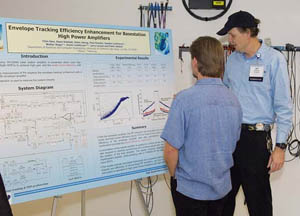UCSD Researchers Report World Record Efficiency for High-Power Amplifiers for Cellular Base Stations
October 31, 2005 / By Doug Ramsey
San Diego and Palm Spring, CA, October 31, 2005 -- Wireless base stations are only as good as the amplifiers that extend their range to provide coverage for cell-phone users. Yet efficiency is typically only 10 percent for high-power amplifiers used in the base stations of third-generation wireless systems, which means they require ten times more power than they generate. Now engineers at the University of California, San Diego and industry collaborators have achieved greater than 50 percent efficiency -- a record which could foretell more powerful base stations.
|
The record was announced today at the 2005 Compound Semiconductor IC Symposium in Palm Springs.
"Using our device we achieved more power with less heat, while maintaining better gain," said Don Kimball, principal development engineer in the California Institute for Telecommunications and Information Technology (Calit2) at UCSD. "This technology could also boost the life span of base stations, which are designed to last ten years but often last less than three."
The 50.7 percent power added efficiency (PAE) is believed to be the best efficiency reported for a single stage base station power amplifier. At 50 percent PAE, 60 watts of output power would require only 120 watts of DC power, rather than the 600 watts required by today's high power base stations which operate at 10 percent efficiency (although previous studies have recorded peak efficiencies of approximately 25 percent).
The record was achieved during recent tests in the High-Power Amplifier Laboratory of the UCSD Division of Calit2. The research was partly funded by Nokia and the UC Discovery Grant program.
Kimball's co-authors on the study include Electrical and Computer Engineering professors Peter Asbeck and Larry Larson; UCSD graduate students Chin Hsia and Jinho Jeong; QUALCOMM researcher and UCSD grad student Paul Draxler; Nokia's Sandro Lanfranco; as well as Kevin Linthicum and Walter Nagy, researchers from Nitronex, the company that fabricated the amplifier design.
High PAE is critical if a power amplifier is going to be cost-effective and reliable without generating too much heat. According to Kimball, the improvement was possible for two principal reasons. First, his team used a transistor made of gallium nitride (GaN), one of several advanced 'compound' materials that promise better characteristics than the silicon on which most current amplifiers are based. GaN transistors -- specifically, heterojunction field effect transistors, or HFETs -- can provide higher voltage and higher power density than other high power semiconductors based on materials such as gallium arsenide (GaAs), indium phosphide (InP), and silicon germanium (SiGe).
"These research results will help to cement gallium nitride as the transistor of the future for high-powered radio frequency amplifiers," said Kimball, lead author on the paper.
Secondly, the UCSD amplifier employed a novel architecture based on 'envelope tracking,' a technique involving variable power signals, instead of the constant feed of DC voltage that is common in high-power amplifiers. The technique achieves both efficiency and high linearity.
According to their paper*, the researchers found that "the efficiency attained in the envelope tracking amplifier is dramatically better than that obtained with constant drain voltage, because 1) the amplifier operates closer to saturation, 2) the transistor temperature is maintained at a lower value, and 3) the dynamic peak voltage reaches higher values than can be used for constant drain bias voltages." In short, adjusting the voltage dynamically provides superior results as compared to the constant voltage employed by most of today's high-power amplifiers.
"By combining gallium nitride with this advanced amplifier architecture, it is now clear that we can achieve dramatic improvements in base station power amplifiers," noted Kimball.
The researchers developed a WCDMA base station power amplifier using GaN HFETs on silicon substrates and envelope tracking, and demonstrated "very high efficiency and precise output performance." The average efficiency of 50.7 percent accompanied an average output power of 37.2 watts and gain of 10 decibels (dB). The signal envelope had a peak-to-average power ratio of 7.67 dB.
Today's announcement comes just days after Kimball and his colleagues demonstrated the envelope tracking technique during a research exhibit to dedicate Calit2's new building on the UCSD campus.
At the Palm Springs meeting Nov. 2, Kimball will also participate in a panel discussion on "GaN: The Ultimate High Power, High Voltage Reliable Basestation PA Technology?"
The IEEE Compound Semiconductor IC Symposium (CSICS) -- formerly the IEEE GaAs IC Symposium -- is the preeminent international forum on developments in integrated circuits using compound semiconductors.
* "50% PAE WCDMA Basestation Amplifier Implemented with GaN HFETs," by Don Kimball, Paul Draxler, Jinho Jeong, Chin Hsia, Sandro Lanfranco, Walter Nagy, Kevin Linthicum, Larry Larson and Peter Asbeck. CSICS 2005.
Related Links
Compound Semiconductor IC Symposium
Don Kimball Profile
PDF
KimballPaper.pdf
Media Contacts Media Contact: Doug Ramsey, (858) 822-5825, dramsey@ucsd.edu


